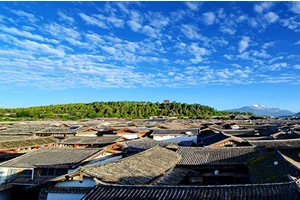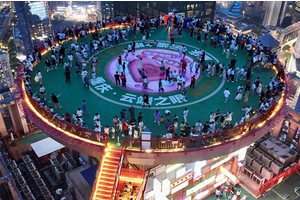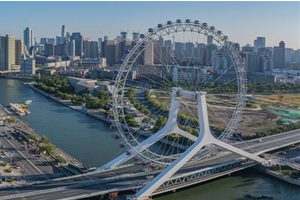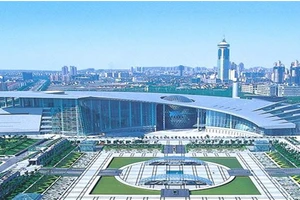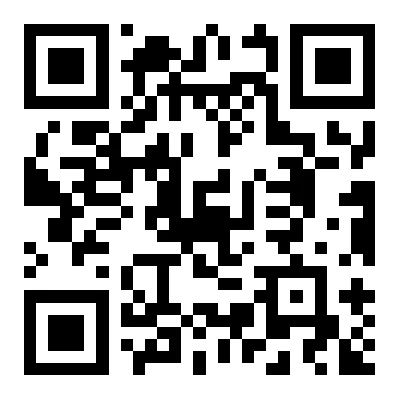Hubei tourism market
1.1 Tourism market scale connotation
The so-called tourism market refers to the sum total of various economic behaviors and relationships between tourists and operators reflected in the process of production and exchange of tourism products. Theoretically speaking, all factors that affect the development of tourism are factors that affect the scale of the tourism market. There are many factors, mainly including the following aspects: (1) Residents' factors, mainly including residents' economic conditions, leisure time and physical quality. (2) Traffic factors, including the convenience and safety of traffic routes in tourist destinations, the status of vehicles in tourist destinations and the status of individual residents owning vehicles. (3) The reception factors of tourist destinations include the grade, quantity and safety of hotels in tourist destinations, and the service quality of tourist destinations. (4) the social, historical and cultural ties between residents and tourist destinations.
There are many indicators to measure the scale of domestic tourism market: from the overall indicators, there are total domestic tourism revenue, total domestic tourists' spending, total domestic tourists' number, etc. From the individual indicators, there are the per capita travel rate of residents, the per capita travel expenses of tourists and the per capita travel expenses of residents. There are many indicators to measure economic and traffic conditions: total GDP, per capita GDP of residents, per capita income of residents, accessibility of transportation, mileage of various modes of transportation and density of various transportation networks, etc., which should be chosen according to the needs of research.
1.2 Wuhan Tourism Market Scale Overview
Wuhan has a good natural ecological environment and rich cultural tourism resources. Tourism products have various types and outstanding characteristics; The layout of urban districts is clear, which has laid a good foundation for the development of urban tourism. During the Eleventh Five-Year Plan period, Wuhan vigorously implemented the project-driven strategy, accelerated the development and utilization of tourism resources and the construction of tourism supporting facilities, with a total investment of 72.511 billion yuan. Based on the development of eight special tourism products in Wuhan, such as urban cultural tourism, red tourism, science and education tourism, water tourism, business tourism, industrial tourism, religious tourism and rural leisure tourism, 48 provincial tourism routes and urban tourism routes with Wuhan as the tourism distribution center were planned and implemented.
1.2.1 Traffic conditions
Wuhan is one of the main railway hubs in China. By 2008, there were red tourist routes to Hong 'an, Macheng, Luotian, Yingshan, Xishui, Honghu, Yangxin and Dabie Mountain tourist areas in Wuhan. The provincial tourist group has also opened inter-provincial red tourist boutique routes such as Shanghai, Nanjing, Taizhou, Nanchang, Ganzhou, Xiangtan and Xi 'an. In the summer of 2006, Xinhua Road, fujiapo and other passenger stations added passenger lines to Guilin, Zhangjiajie, Lushan, Taishan, Huangshan, Tianzhu Mountain and Jingdezhen. Wuhan has 615 berths and 2080 ships of various types, with a total passenger capacity of 60,000 seats. Passenger traffic ranks first in the inland ports of the Yangtze River. Wuhan Port has opened air routes to Chongqing, Jiujiang, Three Gorges and other tourist destinations. The routes of Wuhan Airport can reach 56 large and medium-sized cities in China, and four international routes have been opened to Hong Kong, Macao, Fukuoka, Japan and Cheongju, South Korea.
1.2.2 Travel Agency
By 2008, there were 169 travel agencies (travel companies) in Wuhan, including 16 international travel agencies and 153 domestic travel agencies. Among the international travel agencies, 8 are qualified for outbound group tours, with Changjiang Shipping Overseas Travel Corporation ranking 13th, Provincial Overseas Travel Group Co., Ltd. ranking 44th and China Travel Agency ranking 71st. In recent years, tourism professionals has been continuously trained, so that the certified rate of middle and senior managers in tourism enterprises is 100%, the certified rate of general staff is over 80%, there are 24 senior tour guides, 19 on-the-job and about 136 intermediate tour guides. Vocational schools such as Wuchang Tourism School and Changhang Vocational School, Hubei University Tourism College, Wuhan University Tourism Department, Huazhong Normal University Tourism Department and other undergraduate departments and postgraduate majors can provide a large number of qualified tourism management talents and tourism service personnel for the tourism industry every year.
1.2.3 Tourist reception facilities
By 2008, there were 120 tourist star-rated hotels in Wuhan. Among them, there are 6 five-star hotels, 17 four-star hotels and 54 three-star hotels. There are 15,447 guest rooms and 28,410 beds. And a number of internationally renowned management groups such as Shangri-La, Holiday and Marriott have settled in Wuhan, ending the history of no top hotels in Wuhan. There are 11 designated foreign-related shops and 10 designated foreign-related restaurants in the city. There are also a number of large shopping centers, professional commodity wholesale markets, large food city squares, food streets and restaurants with special flavors, which can better meet the needs of Chinese and foreign tourists. In particular, the proportion of tourism shopping in tourism foreign exchange income has increased greatly in recent years, and the variety, quantity and characteristics of tourism commodities have been greatly improved.
1.2.4 Tourism economy
In 2005, Wuhan received 412,300 overseas tourists, an increase of 31.1% over the same period. The number of domestic tourists received was 934,900, an increase of 35.6% over the same period. The total tourism revenue in the whole year was 23.519 billion yuan, an increase of 16.0% over the same period. Among them, foreign exchange income from international tourism was 172 million US dollars, up 36.5% over the same period, and domestic tourism income was 22.122 billion yuan, up l5.1%% over the same period. From the geographical distribution of tourists, tourists from Hong Kong, Macao and Taiwan and East Asia account for about 40% and 20% respectively, which together account for nearly 60% of the total number of overseas tourists in the city. Tourists from Western Europe, Southeast Asia and North America account for about 20% of the city's total. Wuhan tourism has basically formed a basic pattern with the tourist market in the province and surrounding provinces as the main body and the tourist market in East China and South China as the support. Along the middle and lower reaches of the Yangtze River, economically developed coastal areas and surrounding provinces and regions are the main sources of domestic tourism in Wuhan.
Some data of Wuhan tourism scale in 2009 are shown in Table 1-1.
Table 1-1 Some Indicators of Wuhan Tourism Development Scale in 2009
Indicator Wuhan
Number of domestic tourists (10,000 person-times) 6359.99
Number of overseas tourists received (10,000) 66.90
Total tourism revenue (100 million yuan) 508.65
International tourism (foreign exchange) income (USD 100 million) 3.29
Domestic tourism income (100 million yuan) 486.18
Number of hotels above star level at the end of the year (111)
Number of three-star and above hotels (83)
Number of international and domestic travel agencies (235)
Number of tourist attractions at the end of the year (32)
Number of scenic spots at 4A level and above (each) 10
References:
[1] Zhang Lisheng. China's domestic tourism market size analysis and prediction. Regional Research and Development, 2004 (1): 59-61
[3] Xue Bingwang, Zhao Yonggang. Wuhan tourism economic industrial advantages and development countermeasures. Enterprise Herald, 2011 (7): 158-159.
[2] Xu Mengjing. Realistic basis and countermeasures to enhance the competitiveness of Wuhan tourism. Operation and management, 2008 (4): 79-82
[4] Hu Lei. Comparative Study of Wuhan Tourism Competitiveness. Charming China, 2011 (11): 123-124
This is a lot of literature I have written for you!
The cities suitable for tourism in Hubei are: Wuhan, Enshi, Yichang, Shiyan, Jingzhou, Huangshi and Xiangyang.
1. Wuhan
Most of the tourist attractions in Wuhan are antique engineering buildings. Whether it is the Yellow Crane Tower in the other mountains all appear dwarfs under the sky. or Guiyuan Temple with hazy walls, it shows the imprint left by time in Wuhan. The magnificent Yangtze River Bridge, the beautiful universities in Wuhan, the Jianghan Road Commercial Street and the sweet and delicious Hubu Lane, which are the favorite of contemporary tourists.
In Wuhan, you just have to release the pressure and measure this modern city step by step, where historical events are integrated with contemporary, special food and beautiful scenery.
2. Enshi
Enshi, Hubei Province is dominated by picturesque green mountains and green waters and grotesque caves, which are concentrated in Enshi, Lichuan and Xianfeng, Hubei Province, and there are also some places in Badong and Hefeng. Among them, the key tourist attractions are Enshi Scenic Area in Hubei, Qingjiang River in enshi tusi castle, Hubei, Tenglong Cave, Longchuan Ancient Town, Yumuzhai, Tangya Tusi City, Dashuijing Ancient Buildings Ancestral Temple, Shemi Lake Waving Hall and Suobuya Stone Forest.
In addition, the diaojiao building of Tujia nationality, the wind and rain bridge in Dong township, the daughter in July, the grass-cutting gongs and drums during hard work, the Salho dance at funeral and the waving dance at auspicious times all show the colorful charm of Enshi, Hubei.
3. Yichang
Yichang, the third largest county in Hubei Province, is the city where the Three Gorges Dam on Xiangjiang River is located. Yichang is rich in tourism. The majestic dam, the Three Tour Ancient Cave, the Fairy Tales of White Horse, Dongshan Island painting, Xinghua Village, Children's Park, Riverside Painting Garden, the night view of the city square, Yichang Natural Tower, Yangzhou Pavilion and other garden landscapes are all over the city, and the Baiguoshu Waterfall flies down, which is invincible and spectacular. Lovers Spring has graceful stalactites and jumpsuits in pairs. As lovers embrace each other, Wang Zhaojun's former residence has beautiful scenery, and thousands of years of legends and stories will never fade.
In Yichang, the nourishment of beautiful scenery and water, and the contamination of Bachu culture and art make this lakeside place rush with unique beauty and moving style.
4. Shiyan
Shiyan has beautiful mountains and rivers and a long history, and the natural landscape and human landscape complement each other. In the east, there is a world cultural heritage, Wudang Mountain, a famous Taoist holy place, and Danjiangkou Reservoir, the water source of the Middle Route of South-to-North Water Transfer Project. In the south, there are the virgin forest Shennongjia, the exile culture of Qianlifang County and the hot springs for drinking and bathing. In the west, there are the Chu Great Wall, which historians call the "Inner Great Wall", the beautiful eighteen-mile long gorge and the river-blocking drifting scenic spot. There are rare Cretaceous dinosaur egg fossils and dinosaur skeleton fossils in the north.
5. Jingzhou
Jingzhou is endowed with unique tourism resources, and cultural tourism and eco-tourism are spectacular. The city's tourist attractions present a pattern of "one city and three films". "One City" is the well-known ancient city of Jingzhou, among which Jinan City, Guan Gong Temple, zhanghua Temple, Wulin Ancient Town, Huarong Road and other cultural landscapes are enduring for a long time, and Jingzhou Museum has been rated as the first batch of "4A" museums in China. "Sanpian" refers to Songzi Weishui Scenic Area, Honghu Fisherman Resort and Shishou Swan Island Elk Nature Reserve newly developed in recent years.


